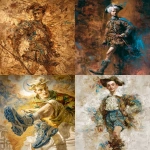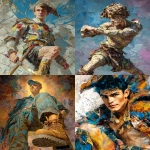Explore the Best AI Image Gallery

AI Images in Design: Transforming the Creative Industry
Artificial Intelligence (AI) is rapidly reshaping various fields, and the design industry is no exception. With its ability to generate complex visual content at an unprecedented speed and scale, AI is transforming how designers approach their work. This blog post explores the impact of AI-generated images on the creative industry, potential use cases, ethical considerations, and future trends that every designer should be aware of.
The Impact of AI on the Creative Industry
The introduction of AI-generated images has brought about significant changes in the creative landscape. Designers can now leverage advanced algorithms to create stunning visuals without traditional manual techniques. AI tools have made it possible to streamline workflows, allowing creative professionals to focus on more strategic aspects of their work. Here are a few ways AI is making waves in design:
- Speed and Efficiency: AI algorithms can generate images within seconds, doubling or tripling the output that a designer could create manually in the same timeframe.
- Unlimited Inspiration: AI can analyze vast datasets and produce endless variations of images to inspire designers, helping them overcome creative blocks.
- Customizability: Designers can use AI to create tailor-made visuals that align with client specifications and brand guidelines without extensive manual edits.
Potential Uses of AI Images
AI-generated images have numerous practical applications across various design disciplines. Some of the potential uses include:
- Graphic Design: AI tools such as DALL-E and Midjourney allow graphic designers to create unique graphics for marketing materials, social media posts, and branding.
- Fashion Design: AI can generate outfits based on style preferences and current trends, assisting fashion designers in visualizing their concepts before production.
- Interior Design: AI algorithms can create realistic 3D renderings of spaces, helping interior designers showcase their ideas to clients effectively.
- Advertising: AI-generated visuals enhance ad campaigns by delivering customized images that resonate with target audiences.
Ethical Considerations
While the advantages of AI-generated images are manifold, ethical considerations regarding their use must be acknowledged. Some key concerns include:
- Copyright Issues: As AI generates images based on existing datasets, the question arises about ownership and copyright infringement. Who owns an AI-generated image, the designer or the software company?
- Quality vs. Authenticity: While AI can produce high-quality images, critics argue that these images lack the human touch, which is often essential in creative work.
- Job Displacement: The efficiency of AI tools might lead to concerns about job security within the design industry, as companies might favor automated solutions over human talent.
Future Trends in AI-Generated Images
The future of AI in design is bright, with promising trends on the horizon. Some anticipated developments include:
- Integration of AI with Augmented Reality (AR) and Virtual Reality (VR): Combining AI-generated images with AR and VR technologies will allow for immersive design experiences and interactive storytelling.
- Improved Personalization: AI will enhance image personalization capabilities, allowing for design solutions tailored to individual user preferences and behaviors.
- Collaboration Tools: Emerging platforms will enable designers to collaborate with AI tools directly, assisting in their creative processes instead of replacing them.
Conclusion
AI-generated images are transforming the design industry, offering countless opportunities for creativity and efficiency. However, as the integration of AI becomes more prevalent, it is essential to navigate the ethical implications it presents. Designers must embrace this technological advancement while remaining mindful of the value of human creativity and intuition. The future of design with AI looks promising, and the creative industry must prepare for these changes, harnessing the power of AI while upholding ethical standards.



](https://images.ai-img.art/thumbnails/150/8c3bd422d50d35735d8fb33bd314a79e30e5b150129d5d09bdad822a2007593f.webp)




](https://images.ai-img.art/thumbnails/150/1614d64dd7156c95db952258978be809eb3db8cea4453fec69c49cbdfe63fa94.webp)


](https://images.ai-img.art/thumbnails/150/3a60737a5b67fa252207ad1ae6db245a26284f53fb5846996bb34515b39ff269.webp)
